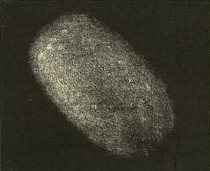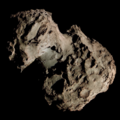| Name(s) | Initially discovered | Period (years) | Last seen | Recovered | Fate |
|---|
| D/1766 G1 (Helfenzrieder) | 1766 | 4.35 | | | Uncertain orbit. Possibly perturbed by Jupiter after 1766 |
| D/1770 L1 (Lexell) | 1770 | 5.6 | | | Probably lost due to a 1779 close encounter with Jupiter which might have greatly perturbed the orbit or even ejected the comet from the Solar System. The asteroid (529688) 2010 JL33 is most likely its inert remnant. |
| 3D/Biela | 1772 | 6.6 | 1852 | | Broke up in two fragments (1846), then thousands, creating the Andromedids meteor shower |
| 226P/Pigott–LINEAR–Kowalski | 1783 | 7.2 | | 2003
2009 | Lost shortly after discovery in 1783 due to uncertain orbit. Rediscovered after Richard Kowalski identified P/2009 R2 and P/2003 A1 as the same object as D/1783 W1 |
| 27P/Crommelin | 1818 | 27.9 | | 1928 | Three independent discoveries linked by Crommelin in 1930 |
| 289P/Blanpain | 1819 | 5.2 | | 2003 | Lost since 1819 discovery due to faintness; rediscovered in 2003 thanks to good viewing conditions; first identified as asteroid 2003 WY25, subsequently matched to the 1819 comet after 184 years and 35 orbits; confirmed by observations in 2013 and 2014 near perihelion; probable source of the Phoenicids meteor shower observed since 1956 |
| 273P/Pons–Gambart | 1827 | 180 | | 2012 | Period of roughly 64±10 years originally computed in 1917 was wrong; rediscovered after 185 years in a single orbit; possibly matches a Chinese observation in 1110 |
| 54P/de Vico–Swift–NEAT | 1844 | 7.3 | 1894, 1965 | 2002 | Lost several times due to perturbations by Jupiter |
| 122P/de Vico | 1846 | 74.4 | | 1995 | Not observed on first predicted return in 1921; recovered in 1995 after 149 years and 2 orbits |
| 5D/Brorsen | 1846 | 5.5 | 1879 | | Lost since 1879 despite good orbit computations |
| 80P/Peters–Hartley | 1846 | 8.1 | | 1982 | Recovered in 1982 after 136 years and 17 orbits; regularly observed since then |
| 20D/Westphal | 1852 | 61.9 | 1913 | | Expected in 1976 but not observed; next possible return in 2038 |
| 109P/Swift–Tuttle | 1862 | 133.3 | | 1992 | Recovered after 130 years as predicted in 1971 by Brian G. Marsden; retroactively matched to observations of 1737 in Europe and 188 AD and 68 BC in China; source of the Perseids meteor shower |
| 55P/Tempel–Tuttle | 1865 | 33.2 | | 1965 | Recovered in 1965 after 99 years and 3 orbits; matches earlier observations of 1366 and 1699; source of the Leonids meteor shower |
| 11P/Tempel–Swift–LINEAR | 1869 | 6.4 | 1908 | 2001 | Recovered in 2001 after 93 years and 15 orbits; not observed in 2008 due to solar conjunction but seen again in 2014 as predicted |
| X/1872 X1 (Pogson) | 1872 | | | | Originally mistaken as the recovery of Biela's Comet |
| 72P/Denning–Fujikawa | 1881 | 9.0 | 1978 | 2014 | Recovered in 1978 after 97 years and 11 orbits, then lost again and recovered in 2014 after 4 more orbits |
| X/1882 K1 (Tewfik) | 1882 | | | | Only seen once during the solar eclipse of May 17, 1882 |
| D/1884 O1 (Barnard) | 1884 | 5.39 | | | Possibly disintegrated after an outburst |
| 15P/Finlay | 1886 | 6.5 | 1926 | 1953 | Regularly observed since 1953 |
| D/1886 K1 (Brooks) | 1886 | 5.44 | | | Uncertain orbital period. Perihelion increased from 1.3 to 1.9 AU |
| 64P/Swift–Gehrels | 1889 | 9.41 | | 1973 | Recovered after 84 years and 9 orbits. Regularly observed since 1981 |
| 177P/Barnard | 1889 | 118.8 | | 2006 | Recovered after 117 years [4] in a single orbit |
| 206P/Barnard–Boattini | 1892 | 5.8 | | 2008 | Recovered in 2008 after 116 years and 20 orbits; not seen on predicted return in 2014; not observed in 2021 due to low magnitude; next perihelion in 2027 |
| 17P/Holmes | 1892 | 6.9 | 1906 | 1964 | Regularly observed since 1964; large outburst in 2007 |
| 489P/Denning | 1894 | 9.4 | 2007 | 2024 | Identified in 2024 as the asteroid 2007 HE4 |
| D/1895 Q1 (Swift) | 1895 | 7.2 | 1896 | | Several perturbations by Jupiter. Shattered remains possibly encountered by Mariner 4 in 1967 |
| 205P/Giacobini (D/1896 R2) | 1896 | 6.7 | | 2008 | Recovered in 2008 after 112 years and 17 orbits; seen in 2015 as predicted; three visible fragments |
| 18D/Perrine–Mrkos | 1896 | 6.75 | 1909, 1968 | 1955 | Lost after 1909, recovered in 1955 and lost again since 1968 |
| 113P/Spitaler | 1890 | 7.1 | | 1993 | Recovered in 1993 after 103 years and 15 orbits; regularly observed since 1994 perihelion |
| 97P/Metcalf–Brewington | 1906 | 10.5 | | 1991 | Recovered in 1991 after 84 years and 11 orbits; orbital period lengthened by Jupiter in 1993 |
| 69P/Taylor | 1915 | 6.95 | | 1976 | Recovered in 1976 after 61 years and 9 orbits; regularly observed since 1977 perihelion |
| 25D/Neujmin | 1916 | 5.4 | 1927 | | Only seen twice; lost since 1927 |
| D/1918 W1 (Schorr) | 1918 | 6.66 | | | Perihelion increased from 1.9 to 3.0 AU |
| C/1921 H1 (Dubiago) | 1921 | 70.0 | | | Was not observed on its 1982 apparition |
| 34D/Gale | 1927 | 11.0 | 1938 | | Only seen twice; lost since 1938 |
| 73P/Schwassmann–Wachmann | 1930 | 5.4 | | 1979 | Broke up into 4 fragments in 1995 and dozens in 2006, yielding the Tau Herculids meteor shower |
| 57P/du Toit–Neujmin–Delporte | 1941 | 6.4 | | 1970 | Recovered in 1970 after 29 years and 5 orbits; observed regularly since 1983 |
| 79P/du Toit–Hartley | 1945 | 5.28 | | 1982 | Recovered in 1982 after 37 years and 7 orbits; regularly observed since 1987 |
| 107P/Wilson–Harrington | 1949 | 4.3 | | 1992 | Lost for 30 years; rediscovered as a Mars-crosser asteroid in 1979; equated with the lost comet in 1992 while searching for precovery images |
| C/1951 G2 (Groeneveld–Palomar) | 1954 [7]
1978 [8] | | 1952 | | Reanalysis of photographic plates in 2023 revealed that both previously lost comets X/1951 G2 and X/1952 C1 were the same object. [9] |
| D/1952 B1 (Harrington–Wilson) | 1952 | 6.35 | | | Intrinsically faint. Perihelion increased from 1.65 to 1.9 AU |
| 271P/van Houten–Lemmon | 1960 | 18.47 | | 2012 | Lost due to uncertain orbit. Rediscovered by the Mount Lemmon Survey as P/2012 TB36 |
| 85D/Boethin | 1975 | 11.2 | 1986 | | Only seen twice; lost since 1986 (expected in 1997 and 2008 but not observed), officially demoted in 2017 [10] |
| 75D/Kohoutek | 1975 | 6.6 | 1988 | | Only seen three times; lost since 1988 |
| D/1977 C1 (Skiff–Kosai) | 1977 | 7.54 | | | Perihelion decreased slightly |
| 157P/Tritton | 1978 | 6.4 | | 2003 | Recovered in 2003 after 25 years and 4 orbits; regularly observed since then |
| D/1978 R1 (Haneda–Campos) | 1978 | 5.98 | | | Only seen once. Intrinsically faint, perihelion increased from 1.1 to 1.3 AU |
| X/1978 W1 (West–Schuster) | 1978 | | | | |
| X/1979 O2 (Kowal) | 1979 | | | | |
| X/1979 O3 (Kowal) | 1979 | | | | |
| 83D/Russell | 1979 | 6.1 | 1985 | | Only seen twice; lost since 1985, probably due to a close encounter with Jupiter in 1988 |
| X/1981 R1 (Stattmayer) | 1981 | | | | |
| 143P/Kowal–Mrkos | 1984 | 10.51 | | 2000 | Recovered in 2000 after two orbits, rediscovered as the asteroid 2000 ET90. |
| 449P/Leonard | 1987 | 6.8 | | 2020 | Identified in 2022 as a rediscovery of a previously lost comet, X/1987 A2 |
| D/1993 F2 (Shoemaker–Levy) | 1993 | | 1994 | | Fragments collided with Jupiter in July 1994 |




